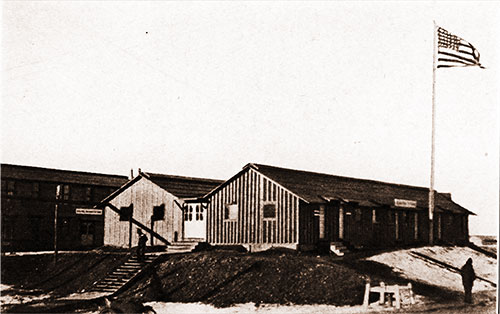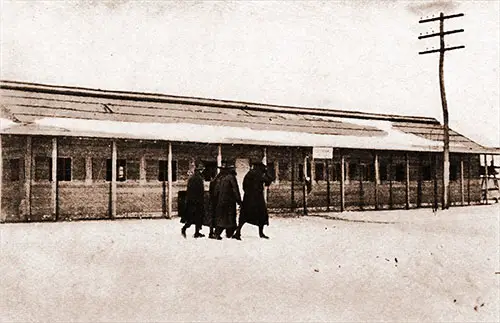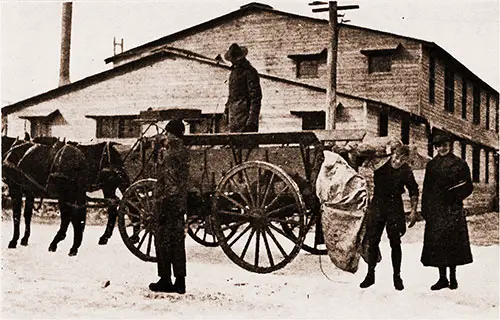Important Buildings at Camp Devens - 1918
A number of important buildings were constructed at Camp Devens including the 76th Divisional Headquarters building, 301st Infantry Divisional Headquarters, Officers' Quarters, Base Hospital Headquarters, Base Hospital Barracks, and the Camp Fire Department.
Camp Devens 76th Divisional Headquarters

Divisional Headquarters, 76th Division at Camp Devens. GGA Image ID # 19c91ff7e4
This building is the military center of the camp, and the headquarters of the 76th division. Here are the offices of the commanding general and his staff, and the headquarters of the principal administrative departments of the camp.
The officers who comprise the staff and "make the wheels go round" at Ayer are :
- Major-General Harry Foote Hodges, Division Commander
- Lieutenant W. W. Cowgill, Aide-de-Camp
- Lieutenant-Colonel M. B. Stewart, Chief of Staff
- Major J. M. Wainwright, Assistant Chief of Staff
- Captain Arthur F. Brown, Assistant Chief of Staff
- Major Harry L. Hodges, Division Adjutant
- Captain T. E. Burleigh, Assistant Division Adjutant
- Lieutenant-Colonel D. M. Dalton, Division Quartermaster
- Major A. M. Pardee, Division Inspector
- Lieutenant-Colonel E. K. Masse, Division Judge Advocate
- Major G. M. Peek, Division Ordnance Officer
- Colonel F. A. Pope, Division Engineer Officer
- Major Chas. A. Lewis, Division Signal Officer
- Lieutenant-Colonel John W. Harmer, Division Surgeon
- Major J. L. Siner, Division Sanitary Officer
- Captain A. E. Foote, Division Post Exchange Officer
These officers are the experts of their branches of the service and it is through them that all orders and memoranda are promulgated and distributed to the various departments of the camp.
The headquarters is on a high hill about a half-mile from the main entrance. The flag on its tall pole, the largest banner in the camp, is visible from nearly every part of the cantonment.
The interior of the building reminds one of the offices of a big corporation. Orderlies are running to and from, bringing in reports, or taking out memoranda to be quickly distributed by motor-cycle riders.
The doors in the front of the building open into the administrative offices, which are equipped with desks and office-chairs, and are literally filled with official documents; the walls of the rooms are covered with maps, notices and typo graphed memoranda.
Camp Institutions

Divisional Headquarters - 301st Infantry - Camp Devens. GGA Image ID # 13a07c4208
This picture shows the administrative building from the side facing the 301st Infantry barracks. In the rear of the headquarters are the barracks of the Headquarters Troop, the only troop in camp. It is generally reputed to be the "crack unit" of the cantonment.
As one of the members said to me not long ago: "Why, I'd rather be right where I am, a private of the troop, than in the boots of any “shave-tail' lieutenant in the cantonment."

Typical Officers' Quarters Building at Camp Devens. GGA Image ID # 13a09bb0eb
The officers' quarters are ordinarily in a line behind the barracks of the organization to which their occupants are assigned. They are about sixty feet long and their capacity, at the most, is thirty officers; few of them have this number, however. Majors and captains have private rooms, while the lieutenants bunk two in a compartment.
At the extreme end of the quarters (in this case, at the left) is the officers' mess and the kitchen. The officers are required to provide for their food from their pay; cooks and waiters, — called kitchen police — are assigned from the enlisted men of the battalion. Other orderlies clean the quarters, make the beds and keep in condition the equipment of their superiors.

Headquarters, Base Hospital at Camp Devens. GGA Image ID # 13a0b22d3d
The base hospital is in the rear of the camp, and is completely isolated from the other organizations. It consists of an administrative building, and long rows of hospital barracks for the patients. Certain houses, apart from the main group, are intended for such contagious diseases as may occur from time to time.
On an average, eight hundred men are treated at the hospital every day. This number does not betoken an alarming percentage of illness, as every man with the slightest disorder or complaint is sent to the base, and many are found to be afflicted by trivial or by imaginary indispositions; it would be difficult to find a civil community of 30,000 people, each individual leading an active life, with only 800 in imperfect physical condition.

Barracks, Base Hospital at Camp Devens. GGA Image ID # 13a0df0e6a
Camp Fire Department

Fire Station No. 1 - Fire Headquarters at Camp Devens Showing Fire Truck 1A. GGA Image ID # 13a1909aea
When the camp was being built, the authorities realized the great danger from fire in the hundreds of wooden buildings and made provisions for a camp fire department. By the time the draft men had arrived, the several fire stations were finished, and a number of Ford trucks, the property of the Quartermaster's Corps, completely equipped and ready for any contingency which might arise.
Those draft men who had previously had experience as firemen were attached to the fire department and supplemented by men from the Quartermaster's Corps. Lieutenant George H. Whitney, a Harvard man from Boston, who had previously attained much notoriety as a "fire fiend," was appointed chief of the department.
He organized his men, formulated elaborate schemes for fire prevention and planned carefully to cope with any possible conflagration. A numerical system of fire alarms, similar to that employed in the cities, was adopted, and a loud whistle which can be heard for several miles, installed in one of the power-houses.
There was little need of the department until the cold spell of October came on. All the barracks and officers' quarters were then heated by small oil stoves, which proved to be of the high-explosive variety. For no apparent reasons, these stoves exploded regularly and with lamentable results. A number of the buildings caught fire, and several burned to the ground; it was due to the efficiency of the department alone that a general conflagration was averted.
The responsibility for putting out fires is not limited to the fire department, but extends to every soldier in camp. When the fire-alarm sounds, all the companies in the vicinity come to the rescue and aid the firemen. In order that the hydrants may give the greatest possible pressure, the water supply is turned off in the buildings until recall blows. The authorities have drawn up a set of drastic rules for fire prevention, particularly adapted to the existent conditions at camp; these are strictly enforced.
Other Important Buildings at Camp Devens

Regimental Post Exchange, 303rd Infantry at Camp Devens. GGA Image ID # 13a1e5b096
The great joy of the soldier's life is the regimental post exchange. At his company canteen he can buy tobacco, candy or other minor luxuries, but at the exchange he can get anything from a needle to a washtub. Every article which the man in khaki needs or likes is on sale. There are all kinds of food, mostly put up in packages, a variety of cigarettes which would rival that of a city tobacconist, stationery, books, post-cards, toilet articles, ad infinitum.

Heating Plant at Camp Devens. GGA Image ID # 13a1d1c544
Probably there has been no matter more widely discussed than that of heat at the cantonment. During the cold days of October, the pipes were not yet ready, and the temperature of the barracks was not very high. At that time there was considerable complaint, principally from the newspapers of the small cities and towns. It is too cold at Ayer, they said.
The heating system once in operation, there soon came to be little cause for complaint. The barracks are cold in the morning because the windows are open at night, but by the time breakfast is over the sleeping rooms are reasonably comfortable. This picture shows one of the heating plants from which the steam is piped to the barracks in the vicinity.

Getting Grub for Soldiers the Day - Shown Here Delivering a Quarter of Beef. GGA Image ID # 13a1ce3e6b
Each morning the supply wagons bring to the kitchen the commodities for which the mess sergeant has requisitioned. One wagon brings bread, another meat, and so on. Here we have one of the kitchen police receiving the allotted amount of meat for his company. The sergeant who accompanies the wagon has just checked off the allowance of that company.

The Guard House at Camp Devens - Turn Out the Guard. GGA Image ID # 13a1b2f701
Each regiment has a guard-house, and under ordinary circumstances, a different company is daily assigned to guard duty. One-third of the entire number are always at their posts; the remainder wait at the guard-house until their turn comes for active duty, or until an alarm is sounded. This picture shows two-thirds of the guard of a light field artillery regiment in front of the guard-house.
